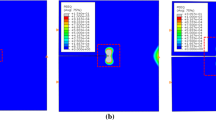Abstract
Aimed at a fresh look onto the defect mechanics of electroelastic medium, the configurational force approach is developed for these materials. The notion of working is defined in a more general framework by introducing the conjugates of configurational force and the evolution velocity of migrating control volume. The balance of configurational forces is established through the invariance condition of working under the change of material observer. Eshelby relation is identified by using the invariance requirement of configurational working under reparameterization of the motion of the boundary of migrating control volume. Energy dissipation concentrated at crack tip is evaluated through the generalized mechanical version of the second law of thermodynamics applicable to migrating control volume. Theoretical investigation shows that the negative projection of the internal configurational force concentrated at the crack tip along the direction of crack propagation plays the role of energy release rate which depends on constitutive response of materials and is independent of the energy of free electric field.
Similar content being viewed by others
References
Chen X (2009) Crack driving force and energy-momentum tensor in electroelastodynamic fracture. J Mech Phys Solids 57: 1–9
Dascalu C, Maugin GA (1994) Energy-release rates and path-independent integrals in electroelastic crack propagation. Int J Eng Sci 32: 755–765
Dascalu C, Maugin GA (1995a) On the dynamic fracture of piezoelectric materials. Q J Mech Appl Math 48: 237–254
Dascalu C, Maugin GA (1995b) The thermoelastic material-momentum equation. J Elast 39: 201–212
Eischen JW, Herrmann G (1987) Energy release rates and related balance laws in linear elastic defect mechanics. J Appl Mech 54: 388–392
Eshelby JD (1951) The force on an elastic singularity. Philos Trans R Soc Lond A 244: 87–112
Eshelby JD (1975) The energy-momentum tensor. J Elast 5: 321–335
Fagerström M, Larsson R (2000) Approaches to dynamic fracture modelling at finite deformations. J Mech Phys Solids 56: 613–639
Green AE, Rivlin RS (1964) On Cauchy’s equations of motion. Z Angew Math Phys 15: 290–292
Gurtin ME (1995) The nature of configurational forces. Arch Ration Mech Anal 131: 67–100
Gurtin ME, Podio-Guidugli P (1996) Configurational forces and the basic laws for crack propagation. J Mech Phys Solids 44: 905–927
Gurtin ME, Podio-Guidugli P (1998) Configurational forces and a constitutive theory for crack propagation that allows for kinking and curving. J Mech Phys Solids 48: 1343– 1378
Gurtin ME (2000) Configurational forces as basic concepts of continuum physics. Springer, New York
Gao H, Zhang TY, Tong P (1997) Local and global energy release rates for an electrically yielded crack in a piezoelectric ceramic. J Mech Phys Solids 45: 491–510
Kienzler R, Herrmann G (2000) Mechanics in material space, with application to defect and fracture mechanics. Spring, Berlin
Kalpakides VK, Dascalu C (2002) On the configurational force balance in thermomechanics. Proc R Soc Lond A 458: 3023–3039
Maugin GA, Epstein M (1991) The elctroelastic energy-momentum tensor. Proc R Soc Lond A 433: 299–312
Maugin GA (1993) Material inhomogenities in elasticity. Chapman and Hall, London
Maugin GA (1995) Material forces: concepts and applications. Appl Mech Rev 48: 213–245
Maugin GA (2000) On the universality of the thermomechanics of forces driving singular sets. Arch Appl Mech 70: 31–45
McMeeking RM (1990) A J-integral for the analysis of electrically induced mechanical stress at cracks in elastic dielectrics. Int J Eng Sci 28: 605–613
Pak YE, Herrmann G (1986) Conservation laws and the material momentum tensor for the elastic dielectric. Int J Eng Sci 24: 1365–1374
Pak YE (1990) Crack extension force in a piezoelectric material. J Appl Mech 57: 647–653
Park SB, Sun CT (1995a) Effect of electric field on fracture of piezoelectric ceramics. Int J Fract 70: 203–216
Park SB, Sun CT (1995) Fracture criteria for piezoelectric ceramics. J Am Ceram Soc 78: 1475–1480
Qu ZC, Chen YH (2003) Discussion of the crack face electric boundary condition in piezoelectric fracture mechanics. Int J Fract 123: 151–155
Simha NK, Fischer FD, Kolednik O, Predan J, Shan GX (2005) Crack tip shielding or anti-shielding due to smooth and discontinuous material inhomogeneities. Int J Fract 135: 73–93
Steinmann P (2000) Application of material forces to hyperelastostatic fracture mechanics. I. Continuum mechanical setting. Int J Solids Struct 37: 7371–7391
Wang BL, Mai YW (2003) On the electrical boundary conditions on the crack surfaces in piezoelectric ceramics. Int J Eng Sci 41: 633–652
Wang BL, Mai YW (2004) Impermeable crack and permeable crack assumptions, which one is more realistic. J Appl Mech 71: 575–578
Zhang TY, Zhao MH, Tong P (2002) Fracture of piezoelectric ceramics. Adv Appl Mech 38: 147–289
Author information
Authors and Affiliations
Corresponding author
Rights and permissions
About this article
Cite this article
He, Q., Wu, L., Yu, H. et al. Configurational forces and the application to dynamic fracture in electroelastic medium. Int J Fract 164, 117–131 (2010). https://doi.org/10.1007/s10704-010-9464-y
Received:
Accepted:
Published:
Issue Date:
DOI: https://doi.org/10.1007/s10704-010-9464-y




